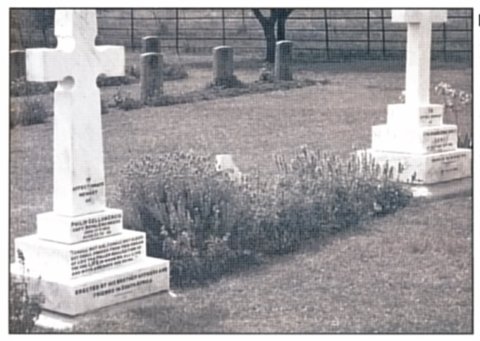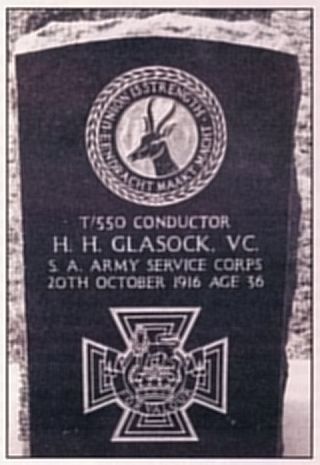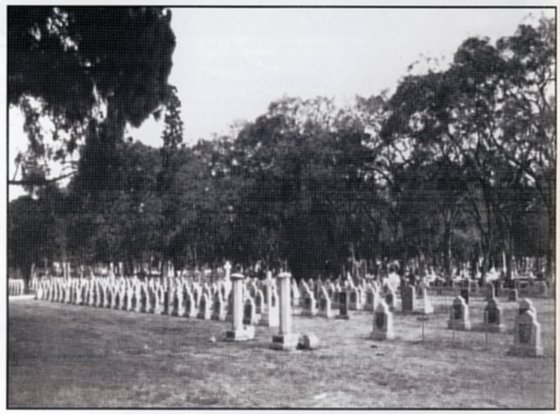

 The South African
The South African
Introduction
While the primary objective of the Commonwealth War Graves Commission is to care and maintain the graves and, where no grave exists, the relevant memorial, of the Commonwealth war casualties from the First and Second World Wars, it does, from time to time, accept agency work on behalf of a member government. Such an agency task was the renovation and maintenance of the graves of the British/Imperial casualties from the South African War (Anglo-Boer War), 1899-1902.
Background
When the guns fell silent following the signing of the Peace Agreement on 31 May 1902, all that remained were the numerous graves of the casualties on both sides as silent witnesses of three years of fierce fighting. Numerous memorials were erected commemorating famous battles and those who died. Various organisations became involved and grave markers, headstones and memorials were erected in formal and informal cemeteries throughout South Africa. Some informal cemeteries were established on farms or outside cities and towns.
Over the years, various organisations were responsible for maintaining the graves and memorials of both the burghers and the British/Imperial casualties from the Anglo-Boer War. Some casualties have been exhumed and re-interred in Gardens of Remembrance in city/town cemeteries. Unfortunately many of these were later neglected, as older cemeteries were no longer maintained and some were vandalised. Cast iron grave markers became a popular item sold as scrap iron.
Based on the research done by Steve Watt and published in In Memoriam: Roll of Honour Imperial Forces, Anglo-Boer War, 1899-1902 (Pietermaritzburg, University of Natal Press, 2000), the South African Agency of the Commonwealth War Graves Commission was requested in 2004 to conduct a feasibility study. The feasibility study identified 220 sites, excluding possible Anglo-Zulu War, Frontier War and Transvaal War of Independence sites. The feasibility study also excluded those sites with less than ten graves unless the site was of historical significance. (Only two such sites were identified, these being the location of the Frere Armoured Train incident in KwaZulu-Natal, where Winston Churchill was captured, and the grave of Able Seaman Jones, the only casualty from HMS Sybell, in Lambert's Bay.) A full report, including an estimate of expenditure, was submitted to the Head Office of the Commonwealth War Graves Commission for the Ministry of Defence of the United Kingdom and Northern Ireland.
The feasibility study was accepted by the Ministry of Defence of the United Kingdom and Northern Ireland and the necessary funding for the project put in place. On 23 September 2005, a formal agreement was signed between the governments of the Republic of South Africa and the United Kingdom and Northern Ireland, transferring the responsibility for the renovation and maintenance of the graves of the British/lmperial Forces' casualties of the Anglo-Boer War to the Commonwealth War Graves Commission. This was followed by the signing of a Memorandum of Understanding between the South African Heritage Resources Agency (SAHRA) and the South African Agency of the Commonwealth War Graves Commission on 10 April 2006. The South African War (Anglo-Boer War) Project was to be completed within five years and, as such, the project should have been completed by 31 March 2011.
Project identification and planning
Of the 220 sites originally identified during the feasibility study, ten would be completely rehabilitated and receive high intensity maintenance. Additional staff were recruited and equipped with vehicles and the necessary tools during the early part of 2006 and initial training took place. The first few sites were jointly renovated by the newly appointed technical assistants. The training was largely based on the work done by the Technical Assistant maintaining the Commonwealth war graves in South Africa. Once the training had been completed, the technical assistants were sent to different areas to commence with the renovations.
Initial planning centred on renovating the smaller sites first, the larger sites to be completed towards the end of the project. In broad terms, the project would be completed as follows:
2006/2007: During this year, 35 sites would be completed, with two sites being completely rehabilitated and receiving high intensity maintenance. The remaining 33 sites would receive basic rehabilitation and a variety of maintenance ranging from regular to no maintenance.
2007/2008: During this year, 55 sites would be renovated, with two being completely rehabilitated and receiving high intensity maintenance. Fifty-three sites would receive basic rehabilitation and a variety of maintenance ranging from regular to no maintenance.
2008/2009: During this year, 55 sites would be renovated with three being completely rehabilitated and receiving high intensity maintenance. The rest, 52, would receive basic rehabilitation and a variety of maintenance ranging from regular to no maintenance.
2009/2010: During this year, 55 sites would be renovated with three being completely rehabilitated and receiving high intensity maintenance. The remaining 52 sites would receive basic rehabilitation and a variety of maintenance ranging from regular to no maintenance.
2010/2011: During this year, twenty sites would receive basic rehabilitation and a variety of maintenance ranging from regular to no maintenance.
To summarise the planning of the project, by 31 March 2011, 220 sites would have been completed, including ten which would receive high intensity maintenance, 75 which would receive regular maintenance, 100 sites, irregular maintenance, and 35, no maintenance at all.
The project kicked off with the sites in KwaZulu-Natal.
Re-scheduling
Although work progressed very well, it became clear at the beginning of the 2009/2010 financial year that the project was falling behind schedule. Various factors influenced the progress, including bad weather and the fact that it took much longer than originally anticipated to renovate the larger sites. Also during the 2009/2010 financial year it was decided to add thirty sites to the project. These included sites from the Anglo-Zulu War, Frontier Wars and Transvaal War of Independence. The additional workload confirmed the realisation that the initial completion date of 31 March 2011 was no longer achievable and a new target date of 31 July 2011 was proposed.
Re-scheduling the outstanding work was done and it was decided to utilise a contractor to renovate certain of the sites. At the same time, the various forms of maintenance were reviewed and a number of contractors were appointed to maintain sites that had already been renovated. As part of the re-scheduling, a number of smaller cemeteries / plots were identified which required minor work and it was decided to renovate these during the first maintenance schedule.
Final phase
By utilising an outside contractor, at the end of the 2010/2011 financial year, the project was largely on track for completion by 31 July 2011, but then bad weather affected the concrete work at the Springfontein Cemetery and the completion date was extended to 31 August 2011. Nevertheless, the project was sufficiently on track that the contract of one of the two technical assistants working on the project was not renewed at the end of July 2011.
By 31 August 2011, only the Thaba Tshwane Old No 1 Cemetery had to be renovated. New nameplates still had to be fitted to the grave markers in the Kimberley West End and Kroonstad Old (North Road) cemeteries. A new panel with the names of those whose discs had been removed from the wall behind the main memorial in the Kimberley West End Garden of Remembrance also still had to be erected. The local stonemason in Kimberley was contracted to complete the work at the sites in Kimberley.

In addition, four new memorials still have to be erected at the Railway Hill Battlefield near Ladysmith, Itala Battlefield, the Waterkloof Heights area and at the Wyatt Road Cemetery in Durban. The memorial at Railway Hill will be erected with assistance from the Ladysmith Historical Society while the Amathole Heritage Initiative will assist with the memorial in the Waterkloof Heights area near Post Retief in the Eastern Cape. It is anticipated that these memorials will be completed by 30 September2011.
Ongoing maintenance
On completion of the project, 238 sites had been renovated and would be maintained as follows:
Intense Maintenance: Horticulture would be established in nine renovated sites which would receive intense maintenance.
Regular Maintenance: Contractors have been appointed for 83 sites to carry out regular maintenance.
Periodic Maintenance: The remaining 123 sites will be maintained by the Technical Assistant who will visit these sites once a year.
No Maintenance: The remaining 23 sites will not receive any maintenance.
Complete rehabilitation and intense maintenance
The following sites were completely rehabilitated:
President Brand Cemetery, Bloemfontein: This is the largest British/Imperial burial site in South Africa, commemorating 1 730 casualties. The cemetery was badly neglected, just about all of the metal grave markers having been removed. Fortunately, the War Museum of the Boer Republics was in possession of 345 of these cast iron grave markers. As no records were available to identify the original graves, they were planted in alphabetical order in a U shape around the main memorial. The impressive main memorial was also in urgent need of repair and this was done while the area around the memorial was developed into a rose garden with the planting of more than 260 roses. During the 2010 Soccer World Cup, the cemetery was part of the tourist route.

Maitland Cemetery, Cape Town: A total of 1 517 casualties are commemorated in this cemetery. This includes 542 British/Imperial casualties from the Anglo-Boer War, 438 Commonwealth war casualties from the First World War and 537 Commonwealth war casualties from the Second World War. In addition, seventeen Commonwealth war casualties from the Second World War are commemorated on the Cremation Memorial. Fortunately the Anglo-Boer War plot is adjacent to the Commonwealth War Graves plot which made it easier to renovate and maintain. A major challenge was keeping moles out of the plot. To achieve this, a one and a half metre deep foundation was cast. The Commonwealth War Graves plot contains the grave of Conductor H H Glasock, VC, who died in the First World War. During the Anglo-Boer War, Driver Glasock, Q-Battery, Royal Horse Artillery, was awarded the Victoria Cross for his action at Korn Spruit on 31 March 1900. Directional signs will be erected in this cemetery.

Pretoria Old (Church Street) Cemetery: This cemetery, with 1 185 graves, has the second largest number of British/Imperial graves from the Anglo-Boer War. A total of 275 grave markers had to be replaced. In addition, there is a large plot with graves of casualties from the Transvaal War of Independence. Three Commonwealth war casualties from the First World War are also buried in the cemetery. In cooperation with the Tshwane/Pretoria Municipality, the border of the military plots will be developed further with the establishment of horticulture.

Fort Napier Cemetery, Pietermaritzburg: A total of 598 casualties are commemorated in the cemetery. This includes 478 British/Imperial casualties from the AngloBoer War, one Commonwealth war casualty from the First World War and 119 Commonwealth war casualties from the Second World War. While the Commonwealth war graves are grouped together, the Anglo-Boer War graves are spread over a large area.
Waverley Road Memorial, Bloemfontein: A total of 235 British/Imperial casualties are commemorated on the memorial. The memorial had to be re-levelled as it was leaning to one side. This required the removal of all the soil around the memorial to allow the memorial to be jacked up, re-levelled and concrete poured to support the memorial. Suitable horticulture is to be established in the four corners of the ring around the main memorial.
Potchefstroom Military Cemetery, Potchefstroom: A total of 228 casualties are commemorated in this cemetery. This includes 104 British/Imperial casualties from the Anglo-Boer War, 93 Commonwealth casualties from the First World War and 31 Commonwealth war casualties from the Second World War. The cemetery is very well maintained by the Department of Public Works.
While all the Anglo-Boer War graves were completely renovated, it is the intention of the Agency, in cooperation with the Department of Public Works, to commence shortly with a complete upgrade of the horticulture in the cemetery which will include installing an irrigation system and planting of new flowers. This project will be completed over two years.
Wyatt Road Military Cemetery:< A total of 156 casualties are commemorated in the cemetery. This includes 78 British/Imperial casualties from the Anglo-Boer War and 78 Commonwealth war casualties from the First World War. In addition, there are graves and memorials of other conflicts, such as the memorial to the British soldiers who died at the Battle of Congella in 1842 which was followed by the siege of the nearby fort and Dick King's famous ride. Renovation of the cemetery was done in conjunction with the eThekwini/Durban Municipality, and some trees were removed while others were cut back to allow more sunlight onto the newly planted turf. This year the cemetery was included on the tour of Durban by the Living Legends Awardees. Once the current re-dedication information panel has been replaced by a granite panel, horticulture will be upgraded further. The eThekwini/Durban Municipality has plans to cover the cemetery with a net and turn it into a butterfly sanctuary.
Rooidam Military Cemetery, Bloemfontein: In this cemetery, a total of 135 casualties are commemorated. This includes 49 British/Imperial casualties from the AngloBoer War and 77 Commonwealth First World War casualties. The supply of water was a major challenge which was overcome with the installation of an underground tank and pump. The established horticulture was upgraded.
Seaforth Old Burial Ground Cemetery, Simon's Town: The Garden of Remembrance contains gravestones and memorials for mariners and soldiers who have died since the occupation of the Cape and includes the graves of 56 who died during the Anglo-Boer War. Unfortunately a number of brass plaques have been removed. As the site is at a steep angle, it had to be divided into smaller plots with curb stones above and below each plot. Horticulture has been established at the main entrance, whereas the smaller plots are covered with coloured gravel chips.
Challenges
During the renovation of the 238 sites discussed above, there were numerous challenges. These included natural threats, such as the presence of the snakes and scorpions, while in some areas physical threats were also encountered, one of the technical assistants being attacked and robbed of the weekly wages owed to the casual labourers. Fortunately the technical assistant was not injured during this incident.
Sadly, vandalism remains a major challenge to the renovated sites. Less than a year after the Garden of Remembrance in the De Aar Old Cemetery had been renovated, the site had been completely vandalised. Cast iron grave markers remain a valuable commodity and three of the 345 markers re-erected in the President Brand Cemetery have already been removed. Marble crosses are frequently damaged.

Conclusion and acknowledgements
While the renovation project presented the South African Agency of the Commonwealth War Graves Commission with numerous challenges, the Agency is very proud to have been involved with the renovation of the graves of the British/Imperial casualties from the AngloBoer War. The ongoing maintenance of the graves will ensure that this part of the South African heritage is preserved for future generations.
On a more personal note, the renovation phase of the project was extremely interesting and rewarding. Numerous friendships have been established, which have proved to be invaluable in keeping the writer informed of the status of many of the sites around the country. These friendships include links with the Durban, Eastern Cape and Johannesburg branches of the South African Military History Society, the Ladysmith Historical Society and many tour guides in KwaZulu-Natal.
It would not be possible for the South African Agency to maintain the various sites without outside assistance and none more so than that provided by the provincial heritage organisation of KwaZulu-Natal, AMAFA. The Agency has concluded an agreement with AMAFA, whereby this organisation maintains a number of sites on the Agency's behalf. The Agency has received numerous compliments for the state of these sites.
All photographs by courtesy, SA Agency, Commonwealth War Graves Commission.
Return to Journal Index OR Society's Home page
South African Military History Society / scribe@samilitaryhistory.org